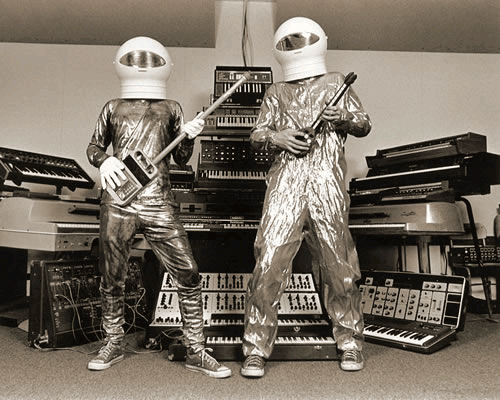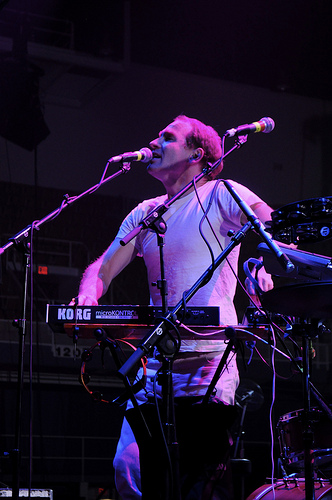On day two of Moogfest, I was ready for some heady electronic music. My itinerary from the previous night had consisted of the whimsical and fun, but it was time to get cerebral. Unlike Big Ears Festival, another one of AC Entertainment’s Southeastern festivals, Moogfest is a pretty even split between entertaining and brainy. As long as you’re into electronic-leaning acts, there’s something for everyone—Big Ears (admittedly my favorite festival) is almost strictly for the intellectually-inclined. And while I like both classes of music featured at Moogfest, I was ready to indulge my smarter inner music fan once again.

L.A.’s own Nosaj Thing (Jason Chung) is always a pleasure to watch—having seen him at Big Ears, I knew how he ticked. He hovers over his sampler and laptop like a spider weaving a web, his hands flinging out and darting back to his work as if he’s creating a very intricate pattern. And really, that’s how his beats build, weaving in and out in a very precise fashion—let’s just say there’s nothing loose or sloppy about the music blaring out of the speakers. He’s almost like a classically trained composer with hip-hop sensibilities. Usually toward the end of his set, his sound gets more bass heavy and more hip-hop friendly, sometimes using a snippet of a traditional rap record and subverting it. It’s extremely inspiring, and it was even more heartwarming to watch how the Civic Center floor filled with people as he played. He certainly got ‘em from bobbing heads to moving bodies.

I hope Nosaj catches on with more people over time—he’s got so much potential.
The next act was a gamble. I had not seen Caribou live, had just a few vague ideas regarding what a Caribou was (besides an animal), and only had the 2010 single “Odessa” to draw upon. I knew that I enjoyed that song enough to give Caribou a chance, hoping that the live act would be strong enough to give me reason to revisit Swim, Caribou’s album released earlier in the year. Caribou’s main mastermind, Dan Snaith, takes a different role onstage. He creates his albums as a one-man show, but in the live setting, the music goes from being self-contained electronic bleepery to full-on bombastic intensity. Snaith sits low to the ground on a stool where he is either playing a synthesizer keyboard or rocking out on some percussion.
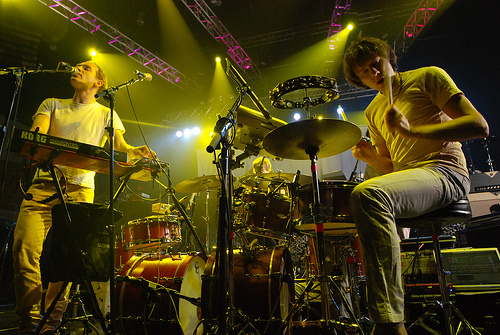
Snaith’s jams might have also lost a bit of their groove (“Odessa” wasn’t as danceable, for instance), but they gained awe-inspiring texture and musicianship. It depends on whether you look at Caribou’s live format as a loss or a victory, but it was enough to wow me and make me want to listen to Swim constantly in the following weeks.
Out of all the weekend’s acts, I don’t think people expected what Jónsi brought to Moogfest. Having spent much of the fall touring North America, word on the street was that his show was not selling well elsewhere on the road, despite the critical acclaim for the ex-Sigur Rós member’s new solo venture, Go. If that cold reception was the norm in other cities, it wasn’t the case in Asheville. It seemed liked everyone from the festival packed in at the Thomas Wolfe Auditorium, which was suddenly much fuller than I’d ever seen it. I looked behind me to see people ascending like a mountain range all the way to the back of the room. It was inspiring. I had a feeling something special was about to happen.
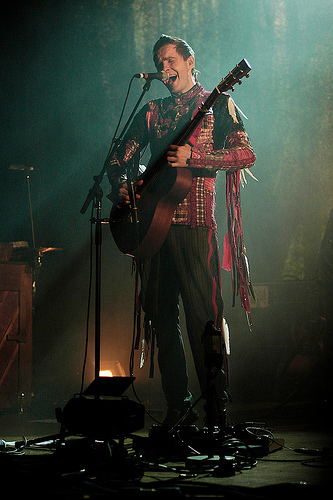
Jónsi came out onstage against a nature-themed backdrop with subtle-yet-breathtakingly gorgeous animations (the Icelanders always have an appreciation for nature that can strike guilt within the average gluttonous, inattentive American). He was by himself at first, performing a stripped-down ballad and emoting with a palpable tenderness and vulnerability. But that’s Jónsi for you—ever since his time in Sigur Rós, he’s been something of a vulnerable frontman, and even more so now that he’s not able to hide behind his bow and electric guitar. He fidgets and avoids eye contact with the audience, hunching over and shutting his eyes so tightly that you wonder if he’s wishing he could disappear or if he’s concentrating on connecting with the music on a spiritual level. It might be a mix of the two.
The rest of his bandmates slowly filtered onstage as the lights lifted up on Jónsi’s silhouette, he was wearing a magnificent matador-meets-Bird King outfit, similar to the cover of his new album. He started up with the more upbeat “Go Do” from Go, and the live band was much like Caribou’s live band: they just made the music so much bigger (something I didn’t think was even possible, given the immensity of the music on Go). Every single person in the audience was just as rapturous as the music, as if they were attending a religious service. Jónsi emanated with warmth that was still somewhat pensive, but that’s just Jónsi’s way. “I like your costumes,” he said meekly in his unmistakable Icelandic accent. The audience returned the compliment with raucous applause and nonstop, quasi-religious movement like you see on those infomercials for Christian rock compilations. It would be safe to say that Jónsi’s Moogfest performance was about as close to a religious experience as it gets, with Jónsi being the priest of humility, joy, and nature.
Massive Attack’s set was the next big must-see for many festivalgoers, and they were certainly top-tier on my list too, but I had a few spare moments for a smaller act I needed to see: Matmos. I’d been fascinated with them ever since I watched Björk’s Live at the Royal Opera House DVD several years ago. They had contributed some of the more microscopic beatwork for her 2001 album Vespertine and accompanied Björk for the album’s lavish, famously over-the-top tour. They performed at Big Ears 2009 but I had to miss out due to time conflicts. I was not going to miss them again.

I made the longest hike of the festival, which was from the Civic Center complex to a smaller venue called The Orange Peel, a place where I had seen quite a few bands perform in the past. I slipped into the venue and the electronic duo was already onstage. Matmos isn’t like most “electronic duos,” though—that term carries a connotation that undoubtedly conjures associations with Justice and Daft Punk. Sure, Matmos make some enjoyable music, but they are primarily experts in ambient and musique concrete. When I got there, they were in the middle of a tropical-sounding sonic experiment, complete with bird calls, beats, and other jungle noises, and after going for some time, they slowly brought the music to a halt. Members Drew Daniel and his real-life partner Martin Schmidt started tearing into what Matmos has earned a reputation for: their hilarious onstage banter.
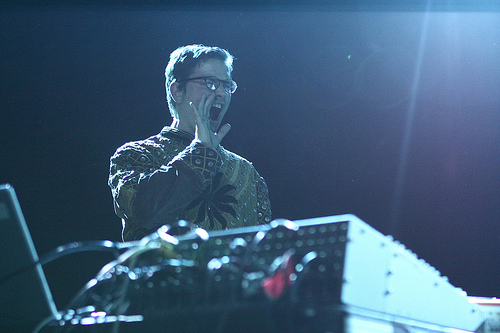
Before starting their next song, Schmidt quipped (in a soothing voice), “First of all, I would like to apologize for using Roland Synthesizers.” They started to segue into piece reminiscent of their album A Chance to Cut Is a Chance to Cure, which was mostly comprised of clips of medical procedures and bodily sounds. Suddenly a deep guttural noise filled the Orange Peel and the lights dimmed even lower. It was unsettling in the same way that Throbbing Gristle’s music is unsettling, and I know that the Gris is a huge inspiration for Drew Daniel, who wrote a book about them. After a while, I decided that I was sufficiently creeped out and scurried on back to the Civic Center where I would join the massive crowd for Massive Attack.
Massive Attack is a legendary group, having been responsible for catapulting the trip-hop genre to near-mainstream status in the ‘90s. Their name alone pulled in a significant chunk of attendees to Moogfest, if the festival’s Facebook page was any indication. I walked in just as they were getting onstage, and while the crowd on the floor wasn’t too oppressive, the surrounding balconies were the fullest I’d seen that whole weekend. Behind Grant, 3D, and the band was a gigantic LED screen that flashed world news and depressing, controversial statistics relating to disease, poverty, and social injustice.
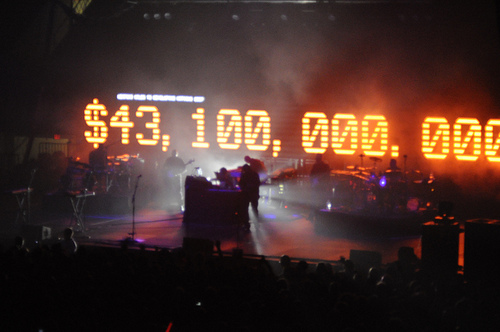
The screen was so mesmerizing that I soon noted the difficulty in paying attention to the people onstage. But it became clear to me that this is what the band wanted: they wanted us to read the screen, in hopes of bringing awareness to our partied-out minds, and simply use the music as background noise. It was easy enough to do. Their performance wasn’t anything short of legendary, either: the feel-it-in-your-bones bass of Mezzanine’s “Inertia Creeps” was enough to make everyone go nuts. Joining them onstage were usual co-conspirators Martina Topley-Bird and Horace Andy, creating just the right classic Massive Attack experience.
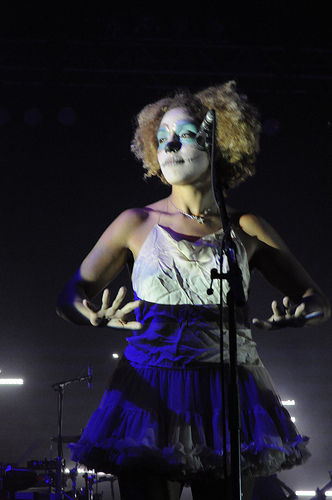
The band exited the stage and I suddenly became very aware of my exhaustion, even though I remained alcohol-free throughout the festival, only being fueled by Pepsi and expensive venue pizza. Perhaps those aren’t the most energy-friendly substances either. Despite desperately wanting to check out Four Tet and Ikonika, two Brits who probably don’t travel over to the States very often, their sets threatened to last until 3am. I decided to call it a night and conserve some energy for the last day in Asheville.

